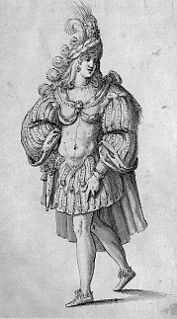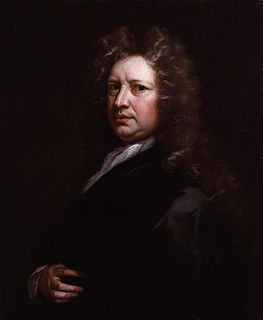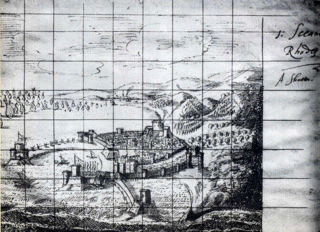Related Research Articles

The masque was a form of festive courtly entertainment that flourished in 16th- and early 17th-century Europe, though it was developed earlier in Italy, in forms including the intermedio. A masque involved music, dancing, singing and acting, within an elaborate stage design, in which the architectural framing and costumes might be designed by a renowned architect, to present a deferential allegory flattering to the patron. Professional actors and musicians were hired for the speaking and singing parts. Masquers who did not speak or sing were often courtiers: the English queen Anne of Denmark frequently danced with her ladies in masques between 1603 and 1611, and Henry VIII and Charles I of England performed in the masques at their courts. In the tradition of masque, Louis XIV of France danced in ballets at Versailles with music by Jean-Baptiste Lully.

Sir William Davenant, also spelled D'Avenant, was an English poet and playwright. Along with Thomas Killigrew, Davenant was one of the rare figures in English Renaissance theatre whose career spanned both the Caroline and Restoration eras and who was active both before and after the English Civil War and during the Interregnum.
Salmacida Spolia was the last masque performed at the English Court before the outbreak of the English Civil War. Written by Sir William Davenant, with costumes, sets, and stage effects designed by Inigo Jones and with music by Lewis Richard, it was performed at Whitehall Palace on 21 January 1640.

Henry Lawes was the leading English songwriter of the mid-17th century. He was elder brother of fellow composer William Lawes.
This article contains information about the literary events and publications of 1634.

Thomas Patrick Betterton, the leading male actor and theatre manager during Restoration England, son of an under-cook to King Charles I, was born in London.
The history of opera in the English language commences in the 17th century.

Matthew Locke was an English Baroque composer and music theorist.

The Siege of Rhodes is an opera written to a text by the impresario William Davenant. The score is by five composers, the vocal music by Henry Lawes, Matthew Locke, and Captain Henry Cooke, and the instrumental music by Charles Coleman and George Hudson. It is considered to be the first English opera.
The terms "semi-opera", "dramatic[k] opera" and "English opera" were all applied to Restoration entertainments that combined spoken plays with masque-like episodes employing singing and dancing characters. They usually included machines in the manner of the restoration spectacular. The first examples were the Shakespeare adaptations produced by Thomas Betterton with music by Matthew Locke. After Locke's death, a second flowering produced the semi-operas of Henry Purcell, notably King Arthur and The Fairy-Queen. Semi-opera received a deathblow when the Lord Chamberlain separately licensed plays without music and the new Italian opera.

The Cockpit was a theatre in London, operating from 1616 to around 1665. It was the first theatre to be located near Drury Lane. After damage in 1617, it was named The Phoenix.
Cupid and Death is a mid-seventeenth-century masque, written by the Caroline era dramatist James Shirley, and performed on 26 March 1653 before the Portuguese ambassador to Great Britain. The work and its performance provide a point of contradiction to the standard view that the England of Oliver Cromwell and the Interregnum was uniformly hostile to stage drama.
Luminalia or The Festival of Light was a late Caroline era masque or "operatic show", with an English libretto by Sir William Davenant, designs by Inigo Jones, and music by composer Nicholas Lanier. Performed by Queen Henrietta Maria and her ladies in waiting on Shrove Tuesday, 6 February 1638, it was one of the last and most spectacular of the masques staged at the Stuart Court.
Lovers Made Men, alternatively titled The Masque of Lethe or The Masque at Lord Hay's, was a Jacobean era masque, written by Ben Jonson, designed by Inigo Jones, and with music composed by Nicholas Lanier. It was performed on Saturday 22 February 1617, and was significant in the development and acceptance of opera in seventeenth-century England.

The Duke's Company was a theatre company chartered by King Charles II at the start of the Restoration era, 1660. Sir William Davenant was manager of the company under the patronage of Prince James, Duke of York. During hats period, theatres began to flourish again after they had been closed from the restrictions throughout the English Civil War and the Interregnum. The Duke's Company existed from 1660 to 1682, when it merged with the King's Company to form the United Company.
Thomas Walkley was a London publisher and bookseller in the early and middle seventeenth century. He is noted for publishing a range of significant texts in English Renaissance drama, "and much other interesting literature."
The Cruelty of the Spaniards in Peru was an innovative 1658 theatrical presentation, a hybrid entertainment or masque or "operatic show", written and produced by Sir William Davenant. The music was composed by Matthew Locke.
The Playhouse to be Let is a Restoration stage play, a dramatic anthology of short pieces by Sir William Davenant that was acted in August 1663 at the theatre at Lincoln's Inn Fields, and first published in the 1673 collected edition of Davenant's works. The Playhouse to Be Let is noteworthy for providing the first English translation of a play by Molière.

Early music of Britain and Ireland, from the earliest recorded times until the beginnings of the Baroque in the 17th century, was a diverse and rich culture, including sacred and secular music and ranging from the popular to the elite. Each of the major nations of England, Ireland, Scotland, and Wales retained unique forms of music and of instrumentation, but British music was highly influenced by continental developments, while British composers made an important contribution to many of the major movements in early music in Europe, including the polyphony of the Ars Nova and laid some of the foundations of later national and international classical music. Musicians from the British Isles also developed some distinctive forms of music, including Celtic chant, the Contenance Angloise, the rota, polyphonic votive antiphons, and the carol in the medieval era and English madrigals, lute ayres, and masques in the Renaissance era, which would lead to the development of English language opera at the height of the Baroque in the 18th century.

The Tempest is a play by English playwright William Shakespeare, probably written in 1610–1611, and thought to be one of the last plays that Shakespeare wrote alone. After the first scene, which takes place on a ship at sea during a tempest, the rest of the story is set on a remote island, where the sorcerer Prospero, a complex and contradictory character, lives with his daughter Miranda, and his two servants: Caliban, a savage monster figure, and Ariel, an airy spirit. The play contains music and songs that evoke the spirit of enchantment on the island. It explores many themes, including magic, betrayal, revenge, and family. In Act IV, a wedding masque serves as a play-within-a-play, and contributes spectacle, allegory, and elevated language.
References
- ↑ Terence P. Logan and Denzell S. Smith, eds., The Later Jacobean and Caroline Dramatists: A Survey and Bibliography of Recent Studies in English Renaissance Drama, Lincoln, NE, University of Nebraska Press, 1978; pp. 194, 197-8, 201, 203-4.
- ↑ Susan Wiseman, Drama and Politics in the English Civil War, Cambridge, Cambridge University Press, 1998; p. 150.
- ↑ Derek Hughes, Versions of Blackness: Key Texts on Slavery from the Seventeenth Century, Cambridge, Cambridge University Press, 2007; pp. 307-12.
- ↑ Ian Spink, Henry Lawes: Cavalier Songwriter, Oxford, Oxford University Press, 2000; p. 111.